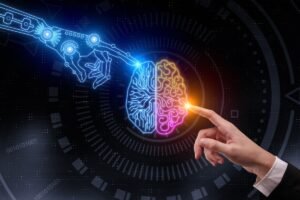Computer vision for robotics may sound like something out of a sci-fi movie, but it’s already a part of your everyday life. If you have ever used Face ID on your iPhone, edited photos with an app like Adobe Photoshop, or even seen a self-driving car navigate the road, then you have already interacted with computer vision.
You see, for us humans, vision is second nature. You open your eyes, and boom you recognize a redwood tree, your pet dog, or even your grandma’s old couch from 1996. But for a computer? Not so easy. In fact, teaching machines to “see” like you do is one of the toughest challenges in artificial intelligence (AI).
Table of Contents
Understanding Computer Vision Today
Back in the 1960s, some of the smartest minds at MIT thought computer vision would be a summer project something a couple of grad students could knock out in a few weeks. Fast forward 60 years, and we are still trying to crack the code.
That’s because a picture is more than just pixels. A single image might hold thousands of visual cues, emotional triggers, and contextual meanings. While older models tried translating images into keywords like “dog,” “car,” or “tree,” newer systems are moving toward a richer, deeper understanding.
Read More The Challenge of Ethics and AI in Healthcare in 2025 | The Real Benefits and Hidden Risks
Why Data is More Important Than You Think
Here’s a truth bomb for you in machine learning, algorithms get all the credit, but data does most of the work. I like to say it’s like giving the Oscars to the director but forgetting the entire film crew. Not cool, right?
Imagine trying to describe every possible bark pattern on a redwood tree using a formula. Impossible. But if you show the system thousands of examples, the model starts to understand. The more diverse and rich the data, the better the machine gets at seeing the world as you do.
And that’s exactly what we do in my lab. we give data the appreciation it deserves.
From Supervised to Self-Supervised Learning
Traditionally, most computer vision models used something called supervised learning. Basically, you give the computer a zillion images, each labeled by a human (e.g., “cat,” “pizza,” “pickup truck”), and it learns to associate those labels with the visuals.
The problem? Human labels come with human bias.
That’s where self-supervised learning comes in. It’s a way for machines to learn from the data itself no human labels needed. It’s kind of like how animals learn from their environment.
In our lab, we mess with images (like poking holes in them or scrambling frames in a video) and ask the computer to guess what’s missing or what comes next. It’s like a visual game of Jeopardy. And it helps machines build a more real, less biased understanding of the world.
How Test-Time Training is Changing the Game
Now let’s talk about test-time training a new approach that helps models adapt on the fly.
You know how you can land in a new airport and somehow figure it out even if you have never been there before? That’s real-time learning. But most AI models don’t work like that. They train on a fixed dataset and then get deployed. If something changes in the real world say snow in Minnesota instead of sunshine in California well, they struggle.
Test-time training changes that. With every new image or data point, the model tweaks itself just a little. It learns, adapts, and improves continuously. That’s a game-changer, especially for applications like self-driving cars, which face all sorts of unpredictable environments.
Read More Understanding Data Privacy and Security in AI 2025 and What You Need to Know
Connecting Computer Vision and Robotics
Lately, there’s been a big buzz around how robotics and computer vision intersect. Think of it as bringing eyes and brains together. A robot with a camera still needs to interpret what it sees before it can act.
More of my students are diving into this space trying to understand how a machine’s “neural network” might mimic how your brain processes visuals. It’s like doing neuroscience, but for computers.
This kind of crossover could unlock next-gen robots that not only move smart but also see smart.
FAQs About Computer Vision for Robotics
Q. What is the difference between computer vision and image processing?
Ans. Image processing focuses on manipulating images (e.g., filters, enhancements), while computer vision is about understanding what’s in an image.
Q. Is computer vision used in smartphones?
Ans. Absolutely! Features like face unlock, AR filters, and photo enhancements in iPhones and Androids all use computer vision.
Q. Can computers really see like humans?
Ans. Not quite yet. They are improving fast, especially with self-supervised learning and test-time training, but true human-like vision is still a ways off.
Q. What is self-supervised learning in computer vision?
Ans. It’s a way for machines to learn from raw visual data without human annotations much like how babies learn from seeing the world.
Q. Why does computer vision need so much data?
Ans. Because visuals are complex! The more varied and detailed the data, the better a model can generalize across real-world conditions.
Conclusion
You might think the coolest part of my work is the tech. But honestly? It’s my students. They are the ones pushing boundaries, asking big questions, and turning theory into real-world impact.
I feel like my biggest contribution to science isn’t just in creating smarter algorithms but in mentoring the next generation of visionaries.





Pingback: The Power of Sensor Fusion in Robotics 2025 - Pickn Reviews
Pingback: How Tactile Sensing in Robotics in 2025 is Revolutionizing Dexterous Manipulation - Pickn Reviews